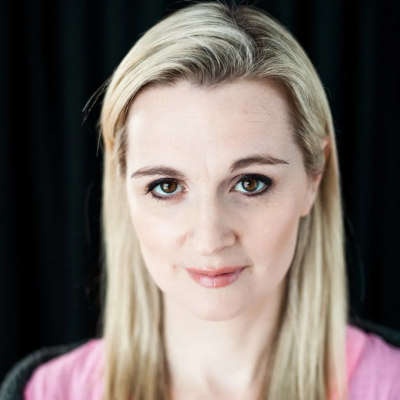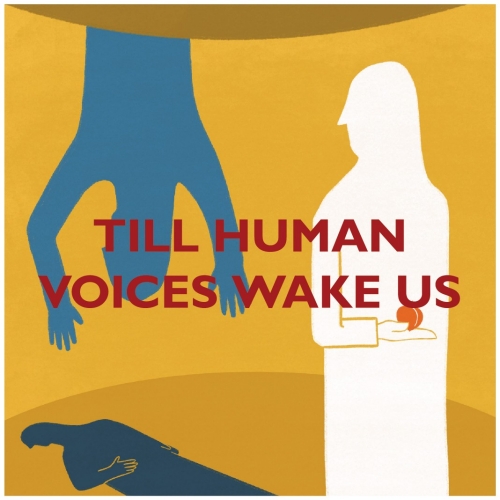"I rarely opt for linear, narrative storytelling."
How did you navigate the challenge of translating T.S. Eliot's poetic and abstract language into a visual and physical experience in Till Human Voices Wake Us?
Shana Carroll: In many ways, poetry and abstract language is really the perfect type of source material for the kind work I like to do. Often my shows are sort of conceptual cubism — a face with the mouth up at the upper left and the eye down at the bottom, at first you might not even see the face but it evokes the face, and eventually when you zoom out and absorb the composite material you can reconstruct it…
I rarely opt for linear, narrative storytelling, but rather a sort of cubism storytelling — out of sequence, evocative, fragmented, deconstructed.
In many ways poetry – and particularly the free verse fever dream that is ‘Prufrock’ – is also deconstructed, evocative, non-linear storytelling. It is indeed one reason I chose it! So, it wasn’t really a question of how to navigate it, more how it navigated us!
How did you incorporate acrobatic elements into the play, and what kind of impact do you think this vertical dimension brings to the overall theatrical experience?
SC: There were certain ideas and imagery that were just given to acrobatic or aerial elements, so when first writing I knew instantly which moments would be expressed in those terms.
For instance, the first scene, in the operating theatre, there is (as the poem references) “a patient etherized upon a table”, where an aerialist is floating above the patient on the table. Is this an out of body experience? An angel of death? A conflation of both? This moment was conceived with this juxtaposition of one character motionless on a bed and another moving freely and weightlessly in the air above; it was the essence of the image.
I also had to keep in mind the skill sets of the five circus artists on this project. Vitor does something called “Boleadoras”, an Argentinian rhythm dance with small balls on ropes. This gave me an idea on how to use it in the tableau about time, its driving relentless rhythm alongside the various types of ticking clocks.
There was of course improvisation. Not so different from creating through more traditionally dance-based improv, but the vocabulary is just wider and bendier and more upside down.
How did you approach integrating circus elements into the production, and what do you hope students will take away from the experience?
SC: The first step, before really integrating major acrobatic elements per se, was working with the theatre students very much through their bodies. This is not new for them; many have dance backgrounds. But even in simple exercises of counterbalance, of physical storytelling, we eased into a work mode that was much more similar to our approach when we create through circus.
When we began incorporating the aerial apparatus, there were extensive “lessons” as to the terms and rules and considerations of high-risk work.
This was mostly technical, but I think the element of risk makes for a more compassionate and empathetic team, because everyone is watching out for and taking care of one another. In circus, our lives depend on it so it is second nature. However, every creative process, every team, every family benefits from this type of trust, empathy and caretaking, regardless if there are people 20 feet in the air or not. My hope is that this mentality of circus ensemble interdependence has worn off on them.
So often the approach in theatre is to process first through the brain, through analysis, embodying meaning after understanding meaning. Circus work is so much more visceral, instinctive, and can have an approach (beauty, metaphor, and drama) that bypasses conscious analysis.
How do you think circus can shape theatre students' artistic vision?
SC: We spoke in length with the students about the function of abstract language — which circus is — and how it resembles dream analysis. When you dream, some corner of your subconscious mind understands something, is trying to say something, which then needs to be deciphered by your conscious mind, after the fact.
My hope for the theatre students is that this little bit of work in the circus domain has helped sharpen that sixth sense for meaning when it comes directly from the gut.
I hope they can start including it in their imaginative thinking, as just one more language they are allowed to dream in! As creators we use the voice that most suits the material, and the more voices at our disposal, the more articulate we are.
Can you tell us more about the workshop you are preparing with Noah Drew, related to the Water for Elephants Broadway production?
SC: Yes! It was so fun to have Noah join us for that! It was great to see him in action outside the university hallways. Water For Elephants will be opening on Broadway in February. I am co-choreographer and circus designer for the production.
We had a run in Atlanta this summer that was wonderful and very informative! We got back in the room and did what they call “pre-pro”, workshopping some tweaks and adjustments, to save time when the entire company hits the rehearsal room.
These particular workshops were a lot of nuts and bolts, figuring out timings and spacings and minor adjustments to story points… Not sure how much fun it was for anyone involved, but so incredibly helpful to us, so we can hit the ground running come January!
Till Human Voices Wake Us will be playing at Henry F. Hall from Wednesday, November 22, to Saturday, November 25.
Find out more about Concordia’s Department of Theatre.



